2017 CDC U.S. TB Elimination Champions
Expanding testing and treatment options of latent TB infection (LTBI)
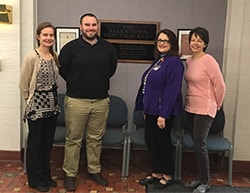
The Allentown Health Bureau TB Control Team in Pennsylvania are definitely TB Elimination Champions. The team is composed of TB Physician/Medical Advisor Marcelo Gareca, MD; TB Control Program Manager Benjamin Lego, MPH, RN-BC, CIC; and TB Control Nurses Margot Messer, RN, Kim Stengele, RN, and Alicia Johnson, MN, RN. The team successfully engaged in expanded testing and treatment for latent TB infection, including: low-cost/free TB screening for the community; incorporation of Interferon-Gamma Release Assays (IGRAs) testing into our practice; and expanded no-cost treatment options for latent tuberculosis infection.
Many employers in the Lehigh Valley require prospective employees to undergo TB testing, normally a TB skin test prior to being given an offer of employment. While the larger hospitals in our area provide this service themselves, many organizations do not. Individuals interested in pursuing a home health or teaching career must go somewhere else to receive this test. Often, these individuals are uninsured and going to a physician practice is out of the question for them. Persons interested in volunteering with the local school district must also undergo TB testing. The Allentown Health Bureau’s public health partners, the Bethlehem Health Bureau, and the Lehigh County State Health Center, do not offer routine walk in testing for TB. The Allentown Health Bureau fills this gap by offering walk-in, routine, TB testing on a weekly basis. The cost for TB skin testing is the lowest in the area, at only $5. If the individual cannot afford the $5 cost, the fee can be waived.
If TB skin testing is contraindicated, IGRA blood test can be offered. Our practice sees a large number of immigrant patients. Often, these patients have received the BCG vaccine within the last five years, which can cause a false-positive TB skin test result. Through hospital contributions, we can provide insured and uninsured individuals the opportunity to receive free IGRA blood testing. Neither of these require an office visit fee or copayment. Being able to provide expanded testing allows our team to quickly and efficiently find persons with latent tuberculosis infection in the community.
Ultimately, individuals who test positive (either through TB skin test or IGRA blood test) are scheduled into our TB Clinic and assessed by our TB physician. Our TB physician and TB control nurses explain the benefits of being treated for latent TB infection, as well as the risk of conversion to active TB disease if they do not receive treatment. The vast majority of these patients agree to treatment. Our TB Control program offers free treatment for latent tuberculosis infection, regardless of regimen. Each patient’s regimen is tailored to their specific needs (treatment length, co-morbidities, adherence risk). Regimen options include nine months of isoniazid (INH), four months of Rifampin, or 12 weeks of INH and Rifapentine. We have had a great deal of success with the 12 dose, once a week regimen. Our current completion rate with it is 100%, with no adverse reactions.
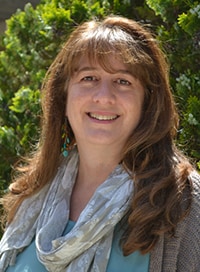
Julie Vaishampayan, MD, MPH, is a champion in promoting TB elimination in California. She is both the TB Controller and the Assistant Health Officer for San Joaquin County Public Health Services. San Joaquin County is located in California’s central valley, and sees an average of 52 TB cases each year. Dr. Vaishampayan is also the 2016-2017 President of the California TB Controllers Association (CTCA); this is a volunteer position where she provides leadership and advocacy on behalf of statewide TB prevention and control.
As the CTCA President, and also as the President-Elect in 2015-2016, Dr. Vaishampayan has been involved in numerous efforts to advance TB elimination in California. As a representative of the 61 local health jurisdiction TB programs in the state, she advocated for the California TB Elimination Challenge Fund in 2016, developing materials for, and meeting with, key members of the California State Assembly. This advocacy effort was ongoing, and Dr. Vaishampayan consistently stepped forward to do this important work. She built momentum and support from CTCA’s partners in the California Conference of Local Health Officers whose advocacy arm, the Health Officers Association of California, formally endorsed the effort that she led. Dr. Vaishampayan’s other advocacy efforts include identifying and reaching out to more than 20 of California’s federal representatives of jurisdictions with the largest TB burden to provide information about TB and how it is affecting their constituents.
As CTCA President, Dr. Vaishampayan has participated in a number of other activities to promote the expansion of latent TB infection (LTBI) testing and treatment in California. A major effort was her participation on the planning committee of the CTCA annual educational conference in 2016 that focused on LTBI. She was the facilitator for this conference which drew 180 participants from across California and beyond. The conference focused on TB elimination, in particular identifying opportunities and methods for scaling up testing and treatment of LTBI. In 2016, Dr. Vaishampayan created a CTCA subcommittee to conduct outreach to private providers to educate and encourage expansion of LTBI testing and treatment. A goal of that group is to develop and compile existing resources for private providers working with high-risk populations throughout the state.
Dr. Vaishampayan is also a member of the California TB Elimination Advisory Committee (CTEAC). Representing the CTCA, she participated in a meeting in late 2015 to develop a draft TB elimination plan for the state of California. In 2016, she was instrumental in moving that draft plan to a current version that has since been disseminated both statewide and nationally. She continues as a member of CTEAC to monitor the implementation of the California Tuberculosis Elimination Plan 2016-2020.
Dr. Vaisampayana has shown exceptional vision, leadership, and passion for creating a California free of TB. Her exemplary work consistently inspires her staff and her collaborations, as well as TB prevention and control professionals throughout the state.
The North Carolina (NC) TB Control Program has focused on increasing uptake and completion of treatment for latent TB infection (LTBI) by taking a patient-centered approach to care. Dr. Jason Stout, the NC TB controller has led the efforts, with an incredible team made up of Julie Luffman, Myra Allen, Elizabeth Zeringue (now retired), Jean-Marie Maillard, Jennifer Wheeler, Ellen Forte berry (now retired), and Jeanette Green.
The team promoted the use of short-course treatment regimens for latent TB infection, particularly 4 months of rifampin and 12 weeks of isoniazid/rifapentine. In order to facilitate safe use of these regimens, Dr. Stout and his team rewrote the state TB manual to provide guidance for use of these regimens, including assessment for drug interactions. The program also worked tirelessly to strongly promote use of these regimens in the state’s larger counties (where the majority of patients with latent TB infection and active TB disease are treated), encouraging providers in these counties to switch regimens, while also providing support and consultation to these health care providers. Furthermore, Dr. Stout’s team worked with state legal counsel to permit the use of Skype and Facetime to perform video-Directly Observed Therapy (DOT), including video-Directly Observed Preventative Therapy (DOPT) for the isoniazid/rifapentine regimen. This has facilitated use of this regimen by reducing patient and health department time, costs, and travel. Finally, routine monitoring was implemented to examine use and safety of the isoniazid/rifapentine regimen, noting a significant increase in use of this regimen without any major safety issues.
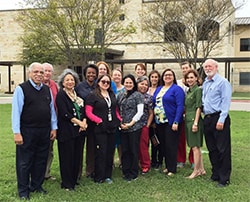
Breathe Easy South Texas (BEST) is a project utilizing Texas 1115 Medicaid Waiver funds to expand testing and treatment for latent tuberculosis infection (LTBI), in high-risk populations in twenty South Texas counties. Twenty-five percent of these counties are classified highest risk counties for TB by the Texas Department of State Health Services.
BEST’s target populations include the homeless, substance abusers, foreign born, diabetics, those infected with HIV, healthcare workers, and those living in congregate settings. The BEST Model incorporates outreach and provider education with the specific aim of increasing testing and treatment for those with LTBI to reduce the progression to TB disease, this reducing TB incidence.
Project strategies include outreach and recruitment of providers to participate in the project; education of providers; and access to TB experts for consultation, training, and guidance regarding testing with interferon gamma release assays (IGRAs) and treatment for LTBI using a 12-week, once a week treatment regimen administered by directly observed therapy (DOT) or other regimens as appropriate.
The founding project partners include the Texas Department of State Health Services Region 8, University Health System -University of Texas Health San Antonio, Heartland National TB Center, and the City of San Antonio Metropolitan Health District. This partnership is responsible for planning and implementing activities to expand testing and treatment in a large geographical area with county populations ranging from over 1.85 million to small rural counties of less than 810 residents. The partnership includes a growing network of urban, suburban, and rural medical providers who commit to screen, test, and treat populations at high risk for LTBI.
Successes
- Project staff reached out to over 75 providers located in 20 counties
- Currently 26 unique sites are participating in the project
- 192 individuals have been trained, including 42 eligible providers (physicians, nurse practitioners, and physician assistants)
- 22 eligible providers are now performing IGRA testing for the first time
- 15 formal agreements have been executed representing 22 rural clinics/facilities in 14 counties
- 8,684 high-risk individuals have been tested
- 682 persons with positive tests for LTBI have been identified
- 355 individuals were diagnosed with LTBI
- 205 LTBI patients were started on treatment
- 144 LTBI patients completed treatment (70% of possible completers)
- 3 cases of active TB were identified
- 25.84% reduction in the number of TB cases in San Antonio since 2014
BEST’s focus on high-risk populations has identified a significant number of persons with latent TB infection in need of treatment who otherwise may not have been detected. The BEST Project will continue to expand activities in an effort to continue reducing TB throughout the region.

Dr. Pennan Barry is the Chief of the Surveillance and Epidemiology Section in the Tuberculosis Control Branch, California Department of Public Health. He provides epidemiologic and clinical leadership to chart a course for the statewide TB elimination plan in California.
As a medical epidemiologist, Dr. Barry has worked for the past several years to identify populations in which targeted testing and treatment efforts would yield the greatest TB prevention benefit. Dr. Barry works in concert with modelers and stakeholders to project and quantify the relative impact of TB reduction interventions. The results of his work have been disseminated through the TB Control Branch’s work with partners, and through numerous scientific papers and presentations. The results have been used to prioritize TB prevention and elimination efforts.
Dr. Barry successfully led a two-year effort to create a standardized tool for risk-based latent TB infection (LTBI) screening in California. Together with Michael Carson, TB Program Manager in Orange County, California, Dr. Barry conducted an intensive review of literature, including cost analyses, to inform the tool’s content. They then piloted several drafts to ensure the tool’s optimal utility. California now has a useful, user-friendly risk assessment tool and a companion user guide to promote risk-based TB testing. The tool has been shared extensively with local TB control programs and community providers in California and in other states and countries. It has been downloaded 4,500 times from the state website since it was posted in October 2016. The tool has also been posted on other websites, such as that of the Curry International Tuberculosis Center. The tool and the evidence basis behind it has generated interest in proposed legislation to change broad-based LTBI screening to a risk-based assessment among several groups at low risk for TB disease, which may reduce resources spent on unnecessary testing.
The State of Tennessee’s TB Program, HIV/STD & Viral Hepatitis Program, Information Technology Services, Laboratory Services of the Department of Health, and the Department of Corrections collaborated to provide testing for TB infection and other diseases with overlapping risk factors, including HIV, syphilis, gonorrhea, and chlamydia, for all inmates at the state’s two correctional intake centers. This multidisciplinary collaboration required protocol development, resource assessment, coordination of new testing practices at the state public health laboratory, and training the Department of Corrections personnel, and electronic reporting of laboratory results. In regard to TB infection, the tuberculin skin test (TST) was replaced with QuantiFERON® TB-Gold In-Tube (QFT), an interferon-gamma release assay performed by the Tennessee Department of Health Laboratory Services. The initiative began in October and November 2015 at two intake prisons (men and women). For 2016, the team performed 5,914 QFTs at the men’s intake facility and 996 at the women’s intake facility (total between both prisons 6,910). Between both prisons they have a 5.0% positivity rate. This has cut down on the amount of time it takes to classify inmates and transport them to other facilities (if needed). This was a huge draw to the Tennessee Department of Correction (TDOC) as they considered switching from TSTs to QFT, and which has been the biggest impact. TDOC is now more confident that a positive QFT is truly indicative of TB infection and treatment is offered to every positive QFT (unless they have a record of completing treatment in the past).
As a result of the work of their epidemiologist, who looks up QFT, HIV, RPR, chlamydia, and gonorrhea results on a daily basis and records these results in a database, they are able to provide monthly testing summaries to the Infection Control Nurses (ICNs) at each prison. Prior to this, the ICNs at each prison had to manually count tests and positives for a monthly Quality Assurance (QA) report. They were able to get access to set up the two prisons so that they are able to submit electronic orders for each of these tests to the state lab which involved the work of IT departments at the Department of Health and TDOC. From the lab side if you look at the number of QFTs that were processed at their state lab for just patients seen at local and regional health departments for 2015, the number was 6,036. So when the two prisons came on board, they added an additional 6,910 tests so the workload at the lab doubled. The lab has been extremely supportive and accommodating with this additional workload. Overall, this has been an extremely successful collaboration between the two state agencies, Tennessee Department of Health and Tennessee Department of Correction. They are definitely TB Elimination Champions!

The staff of the TB clinic/TB infection demonstration project team at the Lynn Community Health Center (LCHC) in Lynn, Massachusetts are dedicated TB Elimination Champions. The LCHC has partnered with the Massachusetts Department of Public Health’s TB Program (MA DPH) and the Lynn Public Health Department to implement targeted testing and treatment of latent TB infection (LTBI) among those served by the LCHC. This demonstration project, funded by Centers for Disease Control and Prevention, Division of TB Elimination (DTBE), is a three year pilot project designed to create a comprehensive strategy for addressing latent TB infection. Although actively testing referrals for TB, the LCHC began treating patients when the numbers became so large it was not efficient or effective to send the patients to the state TB clinic. The LCHC clinic staff diagnoses and treats patients for both latent TB infection and TB disease as an effort to be more holistic and patient centered, caring for the TB patients in a medical home that is more accessible to them than the distant TB clinic.
Building on this earlier work and partnership with the MA DPH, the LCHC worked closely with the MA DPH to develop the plan of action and the methodology adopted for this project. The partnership between MA DPH and the LCHC focuses on four interrelated activities:
- Supporting community engagement to address latent TB infection;
- Reducing the stigma around TB;
- Educating health care providers, community organizations, and community members on advances in TB testing and treatment, and
- Providing services to patients with latent TB infection served by the LCHC
The LCHC, guided by and working closely with the MA DPH, has adopted a step wise approach to the challenge of identifying and treating those with latent TB infection who have the greatest risk of progressing to active TB disease. The first step is to work within the existing patient population served by the LCHC. After screening for risk using the targeted risk groups outlined by the recent United States Prevention Services Task Force (USPSTF) recommendation and the Lynn community local epidemiology, patients are given an Interferon- Gamma Release Assay (IGRA) blood test to identify TB infection. For those with a positive IGRA, examination is required to rule out active TB disease. Once TB disease is ruled out and a diagnosis of latent TB infection is made, patients are encouraged to initiate and complete treatment. The second step of the project will be to engage the larger community, to reach beyond those served by the LCHC. The methodology includes using outreach workers from the LCHC to partner with community‐based organizations to screen, diagnose, and treat those with latent TB infection. The lessons learned from this demonstration project will have nationwide implications as the project team develops messaging and outreach efforts that can be adapted for use in other locations and with other patient populations. The data collected during the project will add to the evidence‐based for cost of latent TB infection treatment and the return on investment for cases averted.

Luvette Baldwin and Stephanie Quinn, Health Promotion Managers of the American Lung Association of Georgia (ALAG) are TB Elimination Champions because of the outstanding service that they provide to homeless TB patients in Georgia. Luvette and Stephanie are responsible for housing homeless TB patients in Georgia, and providing food, clothing, personal hygiene kits, and transportation to their patients. District health TB programs know they can always rely on this dynamic duo to help them speedily find housing placement for their homeless patients in a pinch, especially during late Friday afternoon hospital discharges. They show genuine compassion and care for the patients, treat them with respect, and listen to their personal stories. Many patients regard them as trusted friends. They always take after-hours phone calls from lonely and worried patients. They bring home-cooked meals to them during the holidays, and make sure patients have coats and gloves for winter weather. They look for opportunities to uplift their patients, whether it be by encouraging job training, reuniting them with family members, or helping them gain a bit of financial stability. They counsel patients about stable housing once their treatment is complete. Because of the work that they do, homeless TB patients who may have otherwise been lost to follow-up successfully complete their TB treatment.

Luvette and Stephanie are indispensable during difficult and challenging TB outbreaks and contact investigations. When county health departments are investigating TB outbreaks in communities where drug and alcohol abuse are pervasive, or in communities that view the health department with mistrust or hostility, or locations where most of the TB patients refuse to reveal their contacts, or infected contacts don’t take their medications, Luvette and Stephanie step in. They strategize to find fast food restaurants and grocery chains that the community can easily reach, obtain gift cards from these establishments, and provide them to the county health TB programs to give as incentives to promote cooperation in eliciting contacts and promote latent TB infection treatment adherence. In an outbreak in North Georgia that included young children, these incentives and enablers resulted in a 90% treatment completion rate among infected contacts, many of whom were initially uncooperative and hostile to the county health department. Additionally, when TB outbreaks occur in communities where local health providers have not seen TB cases in a long time, Luvette and Stephanie contact local caterers to provide refreshments for Lunch and Learn sessions that the state and local TB programs conduct to raise awareness among health providers. For their perseverance, hard work, and dedication to helping public health programs eliminate TB in the community, and for their kindness to homeless TB patients, Luvette and Stephanie are definitely recognized as TB Elimination Champions.
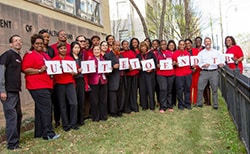
The Fulton County Department of Health and Wellness (FCDHW) Tuberculosis (TB) Program in Atlanta, Georgia, has been battling with an isoniazid-resistant TB outbreak among its homeless community. Fulton County’s 2014 TB case rate was almost three times the national TB case rate.
In response to the outbreak, the TB program developed a strategic plan to reduce the transmission of TB within the homeless community. First was the creation of the TB Taskforce whose mission is to forge a partnership with Fulton County homeless shelter administrators in the fight against the outbreak. The Taskforce, established in collaboration with MercyCare Atlanta, meets monthly to update shelter administrators on the progress of the outbreak, educate on preventive strategies and strengthen partnerships among key stakeholders. Among its many achievements, the TB Taskforce enabled the TB program to implement the requirement that you must have a current TB clearance card in order to reside in a Fulton County shelter.
Despite the challenge of limited staff, the TB managers and staff are labored with daily diligence to combat the TB outbreak. The TB Program addressed the staff shortage by developing the TB Outbreak Response Team – a group of public health staff working solely on addressing the TB outbreak among the homeless. Their mission included conducting routine TB screenings at homeless facilities located in Fulton County to identify clients with latent TB infection (LTBI); perform administrative control compliance checks at the shelters; and administer LTBI treatment. At the beginning, the team provided tuberculin skin tests (TST) and patient education on a daily basis at the shelters where most of the new TB cases were recorded, providing incentives to the clients to encourage their return for TST readings. Currently, the Outbreak Response Team provides routine blood-based TB screenings in addition to TST and HIV/RPR screenings.
The outbreak was associated with isoniazid-resistant TB disease, so 4 months of Rifampin/Rifabutin regimen was selected by the Fulton TB program (per the recommendation of Department of Public Health) for LTBI treatment among the homeless. The treatment is administered through daily directly observed therapy (in clinic or field) by the Outbreak Response Team and TB clinic staff, which has improved adherence and completion rates of treatment.
The effects of these control measures have been seen in all facets of the outbreak. At the end of 2016, only 10 new TB cases were reported among the homeless in Fulton County, showing a 77% decrease in the number of new TB cases among the homeless. In addition, the shelters have demonstrated an improvement in the knowledge and implementation of the administrative controls recommended to reduce TB transmission. Homeless individuals with positive TB screenings received full clinical evaluation and LTBI treatment with about 91% of them beginning treatment.
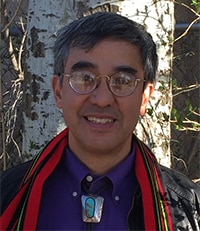
Dr. Jonathan Vilasier Iralu, MD FACP, is the Indian Health Service (IHS) Chief Clinical Consultant for Infectious Diseases (ID). He is particularly recognized for his exceptional advocacy and success in the control of tuberculosis (TB) in Southwestern Native communities.
As the Medical Director of the Navajo Area Indian Health Service (NAIHS) TB control program, Dr. Iralu provides clinical oversight to a user population over 244,000 American Indians in five Federal service units on and near the Navajo Nation. The Navajo Nation is one of the largest Indian reservations in the U.S., consisting of more than 25,000 contiguous square miles and three satellite communities, and extending into portions of the states of Arizona, New Mexico, and Utah. With some of the highest historical rates of TB in the country, this region was the site of critical early trials of modern TB antibiotics in the 1950s due to exceptionally high morbidity and mortality rates.
In his mild but confident manner, Dr. Iralu has long advocated for the education of primary providers in the recognition and treatment of latent TB infection (LTBI). In 2012, he authored the seminal “Navajo Area Chest Clinic Guidelines” which became a model framework for TB clinicians in remote reservation communities. He has personally mentored dozens of internists, pediatricians, family practitioners, and mid-level providers in order to create a network of skilled field clinicians capable of bringing current LTBI treatment to the most remote locales. As the IHS ID consultant, he led the way in adopting the Isoniazid/Rifapentine LTBI regimen (3HP) almost immediately after release of the 2011 Morbidity and Mortality Weekly Report (MMWR) guidelines. He subsequently employed 3HP effectively in conjunction with three major TB outbreaks on the Navajo reservation. Under his clinical leadership, the Navajo Nation saw TB rates decrease from 23 cases per 100,000 population in 1995 to less than 5 cases per 100,000 population in 2015.
Dr. Iralu has also been a passionate advocate for technology and partnership in the control of TB. Working with the Mayo Clinic Regional Training Medical Consultation Center (RMTCC), he helped develop a series of culturally specific TB videos in 2016 designed to promote awareness and acceptance of TB treatment in Native communities. Also in 2016, with the assistance of the Arizona and New Mexico TB programs, he pioneered a dedicated monthly Navajo TB ECHO call to case manage 100% of the region’s TB cases. Providing both clinical consultation and a practical series of didactic learning opportunities for field TB clinicians on the reservation, this call has now expanded in 2017 to include Utah Native American TB cases.
In summary, Dr. Iralu has been the medical cornerstone of Native American TB care in the Southwest. In a harsh underserved environment where clinician longevity averages less than 20 months, he has served as a steadfast advocate of high quality TB care for more than 22 years. Dr. Iralu is truly deserving of recognition as a TB leader, colleague and true TB Champion.
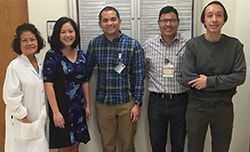
The Los Angeles County (LAC) Department of Public Health (DPH) has been monitoring an ongoing outbreak of TB, primarily among the homeless population in LAC. A plan to coordinate the efforts of all DPH partners was developed that focused on three priority areas; (1.) finding and treating homeless persons with suspected or confirmed TB disease; (2.) ensuring that contact investigations surrounding homeless persons with infectious TB disease are done in a timely manner; (3.) ensuring that all homeless shelter clients receive annual TB testing and screening. While activities surrounding priority 1 and 2 are on-going, this nomination focuses on the efforts of staff assigned to the Satellite Health Center, located on Skid Row in Downtown Los Angeles, who have worked tirelessly with the TB Control Program and other partners to improve latent TB infection (LTBI) outcomes.
In 2016, Los Angeles County reported 46,000 homeless individuals, of which approximately 3,500 are centered in the downtown area known as Skid Row. Community Health Services (CHS), the service delivery arm of the LAC DPH, operates a satellite clinic on Skid Row to provide public health services to all homeless persons in the area, including adult immunizations, flu clinic, and communicable disease triage, and TB services. Staff at the clinic include a TB physician, clinic nurse, clerk, radiology technician, and community worker.
Over the past three years, CHS has gone to great lengths to continuously improve its TB services in hopes of increasing LTBI completion rates among homeless patients, which have traditionally been below 5%. In April 2013, Satellite Clinic staff reduced the length of LTBI treatment by taking the lead in implementing Short Course LTBI treatment (3HP). They also increased the number of clinic sessions to improve patient access to services; and established multidisciplinary teams to discuss difficult patients. In 2015, the staff streamlined the TB evaluation process for sheltered homeless clients by combining services into fewer patient visits before starting LTBI medications. Most recently in 2015, Tuberculosis Control Program (TBCP) worked closely with Satellite Clinic staff to initiate a pilot LTBI housing project for homeless clients, and utilized public health investigators for locating patients who missed LTBI appointments.
As a result, the number of clients enrolling in 3HP has, increased each year and completion rates have been above 65%. The willingness of this staff to implement new and innovative practices and work with this very difficult patient population is a model for LTBI case management.
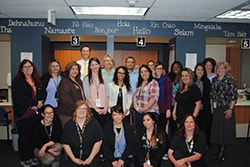
The epidemiology of TB disease in Colorado is driven by untreated latent TB infection progressing to TB disease. Drs. Bob Belknap and Michelle Haas, along with their dedicated and talented team at the Denver Metro TB Clinic (DMTBC), are generous with their time and expertise. This reflects their willingness and desire to work collaboratively with partners and stakeholders throughout the state in joint efforts to eliminate TB in Colorado.
Dr. Bob Belknap has been a regionally- and nationally-recognized TB expert and advocate for all things TB for many years. The DMTBC has been at the forefront of TB treatment best practice for decades. Dr. Belknap has been an especially strong voice for increasing TB funding in an era of ever-reduced budgets. He’s volunteered on the Curry Center warm line for years supporting the entire western region of the U.S. Having worked closely with Dr. Belknap and his clinic staff for 6 years, I’ve seen their drive to increase TB infection screening, testing, and treatment. The DMTBC staff have advocated for and been integral to development of the State of Colorado’s TB elimination plan. At the heart of that plan are strategies and activities to increase screening, testing, and treatment of persons with latent TB infection, most at-risk for progression to TB disease.
Drs. Belknap and Haas and their team have spearheaded the use of Interferon Gamma Release Assays (IGRAs) in the Denver Metro TB Clinic to find those infected with TB. As an urban TB clinic, DMTBC has reached out to and engaged marginalized communities in efforts to address their perception of risk, and engaged them in a dialogue around knowing their TB status. They have worked hand in hand with the Denver-based Lowry Refugee Clinic in efforts to increase completion of treatment for latent TB infection. They have led efforts to utilize newer short-course latent TB infection treatments, most particularly 4 months of Rifampin (4 Rif).
The DMTBC’s efforts to promote and expand the use of 4Rif have been replicated by many of the local public health agencies in Colorado. This led to these agencies asking,” If Denver Metro TB Clinic is doing it, why aren’t we?” They are known to lead by example.
DMTBC staff are currently leading efforts to create a dynamic grand rounds-type World TB Day event in Denver that will be broadcast statewide. This event will engage community health workers and local public health agencies in discussions about how best to engage key communities affected by TB. DMTBC will collaborate with those communities on messaging that resonates about the importance of TB infection screening, testing, and treatment by those most at-risk for progression to TB disease. Denver Metro TB Clinic is leading Colorado’s efforts to eliminate TB.

Becky Scoggin is a Tuberculosis (TB) Nurse Coordinator for the Mississippi State Department of Health. She works primarily in the 9 counties surrounding the City of Jackson. Her job requires providing quality assurance and consultation for TB management for the staff in the local clinics. Prior to taking the role of TB Nurse Coordinator she was a County Coordinating Nurse and TB Nurse. With recent multiple budget cuts and staff reductions, Becky has had to take on additional responsibilities including providing more hands on direct patient care and TB management in local clinics. This includes providing Directly Observed Therapy (DOT) to one of our patients with multidrug-resistant TB (MDR TB).
Her major contribution last year was managing a large TB exposure investigation at a plant. Over 900 individuals were tested at the plant, but the investigation also covered other locations, including: a family planning clinic, pediatric clinic, a trailer-park community, apartment complex, hospital, medical clinic, and interjurisdictional notifications. The follow up identified a numbers of persons with latent TB infection who needed treatment to prevent the progression to TB disease. Becky worked tirelessly to ensure that patients completed treatment, often spending 12-hour days at the plant to reach patients on all three shifts.
Becky recently stated; “TB is not easy to learn because it can be so different with each person. It also has to be very closely monitored because patients can die from drug reactions or the disease. Nurses are often scared of this. But if you are the one that stays with TB, you learn to love it. I’ve had a million hugs and thank you’s, and that is why I continue to do this job.” Becky is leading by example to ensure the work is done.